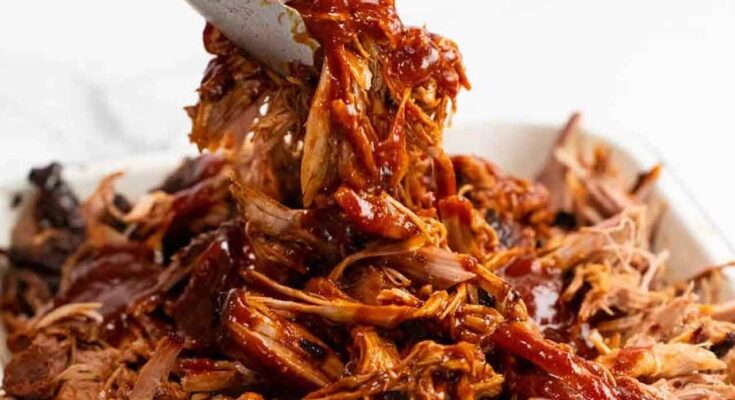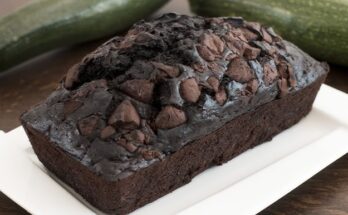Pork Recipe: When it comes to meat options, pork is like a culinary chameleon—it adapts to virtually any flavor profile you throw at it. From sweet and tangy BBQ to savory, garlic-loaded roasts, pork plays well with both bold spices and subtle herbs. It’s no wonder pork is beloved across the globe. Countries like China, the Philippines, Germany, and the United States have their own distinct takes on cooking pork, showcasing its versatility in countless dishes.
Pork can be cooked in many ways—grilled, roasted, braised, pan-seared, or even pressure-cooked. It’s also available in various cuts, which means you can go for leaner choices like tenderloin when you’re watching your diet or opt for juicier options like pork belly when you’re indulging. Pork’s adaptability doesn’t just stop at flavor—it’s also easy on the wallet and can be prepped in bulk for meal planning.
Whether you’re a beginner looking for a reliable protein to master or a seasoned cook trying to level up your meals, pork offers endless culinary possibilities. And with the right technique, it can turn into a tender, mouthwatering main course that earns you compliments every time.
Popular Cuts of Pork You Can Cook
Before diving into the recipe, it’s essential to understand the pork cuts available and what each is best for. Choosing the right cut is half the battle when it comes to nailing that perfect pork dish.
Here are some common pork cuts you’ll often find at the store:
- Pork Tenderloin – This is the filet mignon of pork. Lean, tender, and fast to cook, it’s perfect for quick dinners and soaks up marinades like a sponge.
- Pork Shoulder (Boston Butt) – Loaded with fat and connective tissue, this cut shines in slow-cooked recipes like pulled pork or braised stews.
- Pork Chops – A household favorite. They can be bone-in or boneless and work well grilled, baked, or pan-fried.
- Pork Belly – If you’re aiming for a rich and indulgent dish, pork belly brings flavor and crispiness when roasted or fried.
- Pork Loin – Larger than tenderloin, pork loin is great for roasting and yields juicy slices when cooked right.
Each cut serves a different purpose, so match your method of cooking to the cut. For this step-by-step recipe, we’ll focus on a universally loved cut—pork chops, for their balance of flavor, tenderness, and ease of cooking.
Ingredients You’ll Need
Essential Ingredients for the Base Recipe
Let’s talk basics. If you want a delicious, foolproof pork dish that works every single time, start with the essentials. These are the building blocks of flavor, and with just these few items, you can whip up a restaurant-quality meal at home.
Here’s what you need:
- 4 pork chops (1-inch thick, bone-in or boneless)
- 2 tablespoons olive oil
- 1 teaspoon salt
- ½ teaspoon black pepper
- 1 teaspoon paprika
- 3 cloves garlic, minced
- 1 tablespoon soy sauce
- 1 teaspoon dried rosemary or thyme
That’s it. Nothing fancy, no hard-to-pronounce ingredients—just simple pantry staples that blend beautifully.
You can also adjust the measurements depending on your preference. Want a bit more heat? Add cayenne. Love garlic? Toss in an extra clove. Cooking isn’t rigid; it’s all about tweaking things to your taste.
Optional Add-ons for Extra Flavor
If you’re in the mood to elevate your pork recipe even more, try some of these optional ingredients:
- Honey or Brown Sugar – Adds a touch of sweetness that balances the salt and spice.
- Apple Cider Vinegar or Lemon Juice – A splash of acid helps tenderize the meat and brighten up the flavors.
- Fresh Herbs – Sage, parsley, or cilantro can add a pop of freshness.
- Butter – For a finishing touch, melt a pat of butter over the cooked pork for richness.
- Chili Flakes or Hot Sauce – For those who like a little kick.
These add-ons aren’t necessary, but they can definitely level up the final dish depending on the vibe you’re going for—sweet and savory, tangy and spicy, or herby and aromatic.
Preparing Your Pork
How to Properly Clean and Trim Pork
Before you even think about seasoning or marinating, there’s one crucial step you can’t skip—cleaning and trimming the pork.
Here’s how to do it:
- Rinse and Pat Dry – Rinse the pork under cold running water and pat it dry thoroughly with paper towels. Wet pork doesn’t sear well.
- Trim Excess Fat – Using a sharp knife, trim off any thick layers of fat, especially on pork chops or loin. A little fat is good, but too much can make it greasy.
- Remove Silver Skin – If you’re working with a tenderloin or loin, look for the silvery membrane on the surface. That’s silver skin, and it doesn’t break down when cooked, so it’s best to remove it.
Proper prep ensures the meat cooks evenly and absorbs flavor better. It might feel like an extra step, but trust me, it’s worth it when you take that first juicy bite.
Marinating Tips to Maximize Flavor
Marinating isn’t just about dumping sauce on meat. It’s a science. And when done right, it turns good pork into phenomenal pork.
Here’s what you need to know:
- Time is key – Let your pork marinate for at least 30 minutes, but ideally 2–4 hours. Overnight is even better for a deeper infusion of flavor.
- Use an acidic base – Ingredients like vinegar, lemon juice, or yogurt help break down the fibers, making the meat tender.
- Massage the meat – Get in there with your hands and really rub the marinade into the pork. This helps it penetrate.
- Seal it tight – Always marinate in a sealed container or Ziploc bag in the fridge. This keeps it safe and mess-free.
A well-marinated pork chop is juicy, tender, and bursting with flavor in every bite. Don’t skip this part unless you’re in a serious rush.
Cooking Methods Explained
Pan-Frying Pork
Pan-frying is one of the quickest and most flavorful ways to cook pork chops. It delivers a beautiful crust on the outside while locking in all the juices inside. The secret? High heat and a good skillet—preferably cast iron.
Step-by-step pan-frying instructions:
- Preheat your skillet over medium-high heat for about 2–3 minutes.
- Add oil—about 1–2 tablespoons of olive oil or canola oil. Let it shimmer but not smoke.
- Place your pork chops in the pan gently. You should hear a satisfying sizzle.
- Cook undisturbed for about 3–4 minutes on one side. Don’t move it around; let that crust develop.
- Flip and cook for another 3–4 minutes, depending on thickness. The internal temp should hit 145°F (63°C).
- Let it rest—transfer to a plate and let it sit for 5 minutes before cutting.
The result? Crispy outside, tender and juicy inside, with a nice sear that tastes just as good as it looks.
Roasting Pork in the Oven
Roasting is ideal for thicker cuts like pork loin or shoulder. It’s a “set it and forget it” style of cooking—low maintenance but incredibly flavorful if done right.
Steps to roast pork like a pro:
- Preheat your oven to 375°F (190°C).
- Season and marinate the pork beforehand, allowing the flavors to soak in.
- Use a roasting pan with a rack to elevate the pork, so hot air circulates evenly.
- Cook time varies based on cut and size. Generally, pork loin takes about 20–25 minutes per pound.
- Use a meat thermometer—remove the pork once the internal temp reaches 145°F (63°C).
- Let it rest for 10–15 minutes. The juices will redistribute, making every slice juicy.
Roasting brings out the natural sweetness of pork while maintaining tenderness. Plus, you get those caramelized edges that are just irresistible.
Grilling Pork to Perfection
If you’ve never grilled pork before, you’re missing out. Grilling infuses a smoky flavor that you just can’t get from the oven or stovetop. It’s perfect for summer BBQs—or any time you want to bring a smoky, charred vibe to the table.
Here’s how to grill pork like a pitmaster:
- Preheat your grill to medium-high (about 400°F).
- Clean the grates and oil them to prevent sticking.
- Place pork on direct heat and grill for 4–5 minutes per side, depending on thickness.
- Use a thermometer to ensure internal temp reaches 145°F (63°C).
- Let it rest for 5–10 minutes before serving.
For added flavor, you can baste your pork with BBQ sauce during the last couple of minutes of grilling. It caramelizes beautifully and adds a sticky, savory coating that’s to die for.
Step-by-Step Pork Recipe Guide
Step 1: Choosing the Cut
Everything starts with the cut. For this guide, we’re using pork chops because they’re easy to work with, quick to cook, and incredibly satisfying. You can choose either bone-in for extra flavor or boneless for convenience.
When selecting pork chops:
- Look for a light pink hue with minimal dark spots.
- Choose chops with even marbling—a little fat = a lot of flavor.
- Avoid overly thin chops; go for at least 1 inch thick for the best results.
Good meat makes a good meal—it’s that simple. Don’t skimp on quality if you want that restaurant-level flavor.
Step 2: Preparing the Marinade
A good marinade can elevate your pork from bland to bold. Here’s a simple and tasty marinade to get you started:
Basic Marinade Recipe:
- 3 tbsp olive oil
- 1 tbsp soy sauce
- 2 tsp honey
- Juice of 1 lemon
- 3 garlic cloves (minced)
- 1 tsp dried rosemary or thyme
- ½ tsp salt and pepper
Instructions:
- Combine all ingredients in a bowl or Ziploc bag.
- Mix well until fully blended.
- Taste and adjust—more lemon for tang, more honey for sweetness.
This mixture hits all the right notes—salty, sweet, tangy, and herbal. The acidity tenderizes the meat, while the oils help lock in moisture during cooking.
Step 3: Marinating the Pork
Once your marinade is ready, it’s time to let those pork chops soak up the goodness.
How to marinate like a pro:
- Place pork chops in a large zip-top bag or shallow dish.
- Pour the marinade over them and make sure each piece is well-coated.
- Seal and refrigerate for at least 2 hours, but overnight is ideal.
- Flip halfway through marinating for even coverage.
Don’t skip this step. It makes a huge difference in both taste and texture. You’ll end up with chops that are juicy, flavorful, and totally crave-worthy.
Step 4: Cooking the Pork
Now for the fun part—cooking your pork chops. We’ll use the pan-frying method for this recipe because it’s quick, easy, and delivers a beautiful sear.
Cooking Instructions:
- Heat a skillet over medium-high heat.
- Add a splash of oil and wait until it starts to shimmer.
- Place the marinated pork chops in the skillet.
- Cook 3–4 minutes per side, or until golden brown and cooked through.
- Check the internal temperature with a meat thermometer—145°F is the goal.
- Let rest for 5 minutes before cutting into it.
The result? A golden-brown crust, juicy inside, and flavor-packed bite every time.
Step 5: Serving Suggestions
Now that your pork is cooked to perfection, it’s time to plate it up. Here are some killer sides and garnishes that pair beautifully with pork:
Great Side Dishes:
- Garlic mashed potatoes
- Roasted Brussels sprouts or carrots
- Creamy coleslaw
- Grilled corn on the cob
- Apple and walnut salad
Garnishes and Extras:
- Fresh herbs like parsley or thyme
- A squeeze of lemon or a drizzle of balsamic glaze
- Pickled onions or grilled pineapple for a tangy-sweet contrast
Whether you’re keeping it casual or going all out, these sides and toppings will elevate your pork dish to the next level.
Tips for Making the Best Pork Every Time
Avoid Overcooking
If there’s one golden rule when it comes to cooking pork, it’s this: do not overcook it. Pork that’s overdone turns dry, chewy, and flavorless. The USDA recommends cooking pork to an internal temperature of 145°F (63°C) followed by a short rest. That pinkish center? It’s perfectly safe and incredibly juicy.
Pro tips to avoid overcooking:
- Always use a digital meat thermometer.
- Remove pork from heat just before it reaches 145°F; it’ll continue cooking while resting.
- Don’t cut into it right away—let it rest for 5–10 minutes to keep the juices inside.
Remember, pork isn’t chicken—it’s okay if it’s a little pink!
Use a Cast Iron Skillet for Best Sear
Want that perfect golden crust? Cast iron is your best friend. It retains heat like a champ and distributes it evenly. That’s exactly what you need for a crispy, flavorful sear.
Here’s why it works:
- It holds heat, so you get even browning.
- It’s oven-safe, so you can finish thicker cuts in the oven.
- It naturally enhances flavor the more you use it.
Just make sure to season your skillet properly and heat it up before adding your pork. That sizzle? Music to a home chef’s ears.
Common Mistakes to Avoid
Skipping the Resting Period
After spending all that time cooking pork perfectly, don’t ruin it by cutting too soon. Skipping the rest period causes juices to run out, leaving your pork dry.
Always let it rest:
- 5 minutes for chops or tenderloin
- 10–15 minutes for roasts
This helps the juices redistribute, keeping every bite moist and delicious.
Overcrowding the Pan
Trying to cook all your pork at once? Not a great idea. Overcrowding lowers the temperature of your skillet, leading to steaming instead of searing.
Fix it by:
- Cooking in batches if needed
- Giving each piece room to breathe
- Using a larger skillet or pan
Patience here makes all the difference between soggy pork and a perfect sear.
Storage and Leftover Ideas
How to Store Cooked Pork Properly
Got leftovers? No worries. Cooked pork stores well and can be repurposed in lots of creative ways.
Storage tips:
- Let pork cool to room temperature before storing.
- Place in an airtight container and refrigerate for up to 4 days.
- Freeze for longer storage—up to 3 months.
Reheating tip: Use the oven or a covered skillet to retain moisture. Avoid the microwave unless you don’t mind sacrificing texture.
Delicious Leftover Recipes
Don’t let those tasty pork slices go to waste. Here are a few ways to turn them into new meals:
- Pork Tacos – Chop and reheat with some taco seasoning, throw in tortillas with salsa.
- Pork Fried Rice – Stir-fry with leftover rice, veggies, and soy sauce.
- BBQ Pork Sandwiches – Shred and toss with BBQ sauce, then serve on buns.
- Pork & Egg Breakfast Scramble – Dice and mix into scrambled eggs with cheese and herbs.
Leftovers can be a lifesaver for busy weeknights, and pork’s flexibility shines here too.
Health Benefits of Pork
Nutritional Value
Pork isn’t just tasty—it’s packed with essential nutrients. When cooked properly and enjoyed in moderation, it can be a healthy addition to your diet.
Key nutrients found in pork:
- Protein – Builds and repairs muscles
- B Vitamins – Especially B6 and B12 for energy and brain health
- Zinc – Supports immunity
- Iron – Important for blood health
- Selenium – Antioxidant benefits
For a leaner option, choose cuts like pork loin or tenderloin. Trim visible fat and use healthy cooking methods like grilling or roasting.
Balanced Meal Ideas
Want a nutritious, well-rounded meal? Pair pork with:
- Whole grains like quinoa or brown rice
- Leafy greens or roasted veggies
- A fresh side salad with olive oil vinaigrette
Balanced meals are all about moderation, and pork can fit into just about any healthy eating plan.
FAQs about Pork Recipe
What cuts of pork can I use for this recipe?
You can flex your culinary muscles with various cuts! While our recipe specifically calls for pork shoulder due to its rich flavor and tenderness when cooked slowly, feel free to experiment with pork belly, loin, or ribs based on your taste and what’s handy in your kitchen.
Is this pork recipe suitable for weeknight cooking?
Absolutely! Despite pork’s reputation for longer cook times, our recipe offers a streamlined process that fits perfectly into your bustling weeknight schedule. Quick prep and a hands-off approach mean you can enjoy gourmet flavors on a weeknight timeline.
Can I make this recipe in a slow cooker or Instant Pot?
Yes, and yes! We love a good set-it-and-forget-it meal. For the slow cooker, extend the cooking time and reduce the liquid slightly. In an Instant Pot, you’ll slash the cooking time while keeping all the juicy goodness. Check our detailed guide sections for both methods within the post.
What are the best side dishes to complement this pork recipe?
Think balance and simplicity. Classic sides like mashed potatoes, steamed green beans, or a crisp salad work beautifully. For a heartier companion, why not try roasted root vegetables? They’re especially good at soaking up all those delicious pork juices.
How can I ensure my pork is cooked safely?
Pork’s safety dance is all about reaching the right internal temperature. A meat thermometer is your best friend here. Aim for 145°F (63°C) followed by a three-minute rest. This ensures your pork is not only safe but also succulently tender.
Can I prepare this pork recipe ahead of time?
Definitely! This recipe tastes even better when the flavors have time to mingle. Prepare it a day in advance and gently reheat it before serving. It’s a great strategy for stress-free hosting!
Are there any tips for making this pork recipe even more flavorful?
Oh, for sure! Marinate the pork overnight, sear it to develop a deep crust before slow cooking, and don’t forget to deglaze your pan to capture all those caramelized bits that pack a punch of flavor. Each step layers up the taste!
Conclusion
Cooking pork isn’t complicated, but it is an art. With the right cut, marinade, cooking method, and a little patience, you can create restaurant-quality meals right in your own kitchen. Whether you’re frying up juicy chops, roasting a savory loin, or grilling pork under the summer sky, the possibilities are endless—and always delicious.
From choosing the best cut to adding those final garnishes, every step matters. But don’t stress—follow this guide, and you’ll be well on your way to pork perfection. And don’t forget to experiment! The beauty of pork is that it welcomes creativity and personal flair.
So go ahead—grab that skillet, fire up the stove, and make a pork dish that’ll have everyone asking for seconds.



